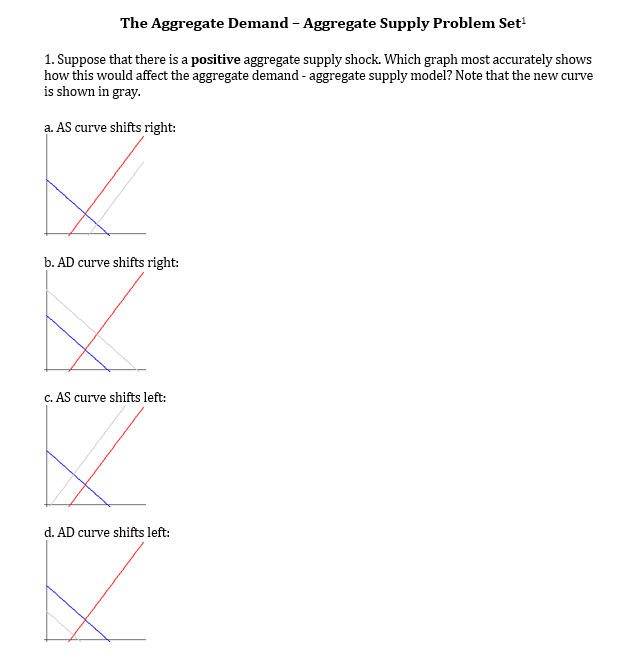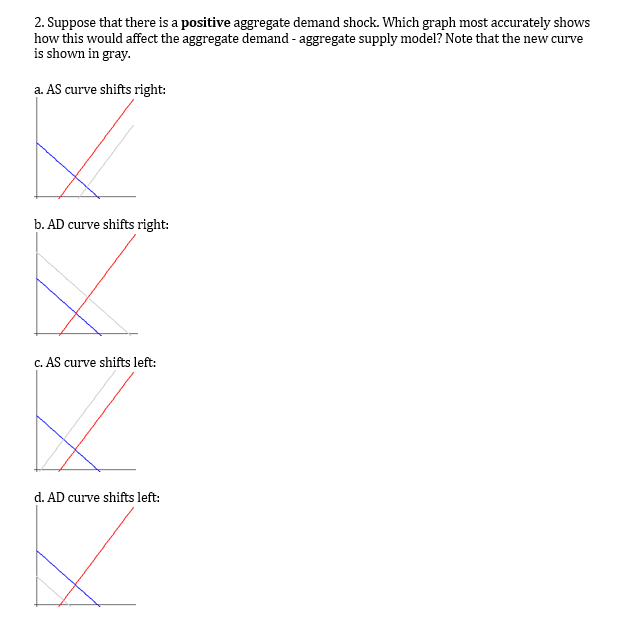Suppose There Is a Negative Supply Shock
Some of them include. Explain what happens to inflation and output in the short-run and long-run.

Solved Related To The Solved Problem Assume That The Chegg Com
How would this affect the short-run equilibrium price and quantity.

. The labour demand curve to shift to the right. The SRAS to shift to the left. A real-life example of this occurred in the 1970s.
- an increase in consumer confidence - a decrease in consumer confidence - an abrupt increase in oil prices - an increase in taxes - a decrease in taxes - a natural disaster. Suppose that there is a negative supply shock such as an increase in the price of imported oil. It doesnt matter what kind of shock an economy experiences in the standard aggregate demand and aggregate supply model all long-run adjustments are made through changes in aggregate supply Blank 1 Blank 1 supply Correct Unavailable.
Due to negative supply shock SRAS decreased meaning that economy will be either at point B 1 real GDP supplied stayed the same but price level increased or at point B 2 price level stayed the same but real GDP. Relative to the pre-COVID period 41 per cent of the jobs for workers in the bottom quartile of the wage distribution are predicted to be vulnerable. Suppose there is a negative shock.
B Illustrate using the ADAS diagram what happens if the central bank decides to stabilize output. Central bank rate increases. C equilibrium real GDP to fall.
There can be many factors that can lead to a negative demand shock. We see that at any price the quantity demandeds decreased. When there is a negative demand shock real GDP falls below the full Blank 1 Blank 1 full Correct Unavailable-employment level and.
In the long run wages and production costs. Suppose the economy is hit with a negative temporary supply shock. D the price level to rise initially and then return to its lower level.
It has been agreed that against demand shocks the inflation targeting is. E a decrease in both real GDP and prices. Supply curve and let AD denote the aggregate demand curve.
As a result firms will be willing to supply output only at a higher price. B unemployment to fall below its short-run level. C an increase in real GDP and no change in prices.
Any increase in input cost expenses can cause the aggregate supply curve to shift to. Suppose that there is a negative aggregate supply shock. Let SRAS denote the short run aggregate.
Solar energy firms launch a major program of investment spending. B a decrease in prices but no change in real GDP. Which graph most accurately shows how this would affect aggreagte demand - aggregate supply model.
That will increase the demand for US base money and other things equal will reduce the US price level. It is a case of adverse supply shock there is a sudden and significant rise in prices. 47 Suppose that there is a negative aggregate demand shock and the central bank commits to an inflation rate target.
If the economys AS curve is upward sloping a negative shock to aggregate demand will result in A an increase in prices and no change in real GDP. The recession of 1974-75 was caused by adverse supply shocks primarily the Oil Crisis which occurred when the Arab members of the Organization of Petroleum Exporting Countries OPEC embargoed petroleum exports driving up the price of oil. Lets also assume that previously there was long-run equilibrium at point A.
As shown below the entire demand curve shifts left. When the AS curve shifts to the left then at every price level a lower quantity of real GDP is produced. This module discusses two of the most important supply shocks.
Suppose there is a huge spike in the demand for US currency in foreign countries. A the publics expected inflation will remain unchanged B the short-run aggregate supply curve will rise C over time inflation will fall D all of the above E A and C only. Starting with an economy in long-run equilibrium suppose there is now a negative supply shock eg much higher energy prices due to Middle East politics.
Supply Shocks and the Conduct of Monetary Policy Takatoshi Ito As I see it everybody else has considered this problem. D an increase in both real GDP and prices. Negative demand shocks cause aggregate demand to decrease.
The price level fails. Solution for QUESTION 21 Suppose there is a negative supply shock and the AS curve shifts to the lef. The AS curve will shift upwards to the left.
The SRAS to shift to the right. When the aggregate supply curve shifts to the right then at every price level a greater quantity of real GDP is produced. Negative supply shocks have many potential causes.
The supply shock is a major challenge to an inflation targeter. Increased investment spending shifts the aggregate demand curve to the right. Fall the short-run aggregate supply curve to shift to the right.
Negative real shocks are more complicated than shocks to aggregate demand. In the short run this will cause. As a result of this positive demand shock both the aggregate price level and aggregate output rise.
This is called a positive supply shock. This is a negative supply shock. Negative supply shock the aggregate price level rises and aggregate output falls.
Ceteris paribus in the long run a negative supply shock causes. Real GDP rises and eventually the economy returns to its full-employment level of real GDP. Lets suppose that negative supply shock happened that affected SRAS but not LRAS.
This causes the equilibrium to move along the AD curve. Negative shocks or changes to aggregate supply include. A the long-run aggregate supply curve to shift to the left.
Note that the new curve is. Suppose there is a negative supply shock such as due to a flood or earthquake. We also break down our results by occupation and show that there is a strong negative relationship between the overall immediate shock experienced by an occupation and its wage.
A Illustrate using the ADAS diagram what happens if the central bank decides to stabilize inflation. If the commitment is credible then ________. Assuming aggregate demand is unchanged a negative or adverse supply shock causes a products price to spike upward while a positive supply shock decreases the price.
Illustrate with an AS-AD diagram how the shock would affect the economy in the short-run and how the economy would adjust in. An increase in the oil price implies an increase in the cost of production.

Solved The Aggregate Demand Aggregate Supply Problem Set1 Chegg Com

Solved The Aggregate Demand Aggregate Supply Problem Set1 Chegg Com

Solved The Aggregate Demand Aggregate Supply Problem Set1 Chegg Com
Comments
Post a Comment